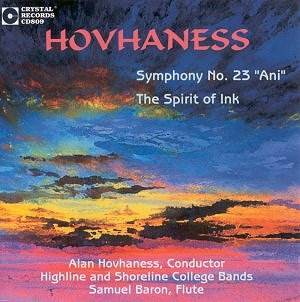This has been a long time in the coming. In
the 1970s the composer’s own Poseidon company issued vinyl and
after vinyl in stark monochrome sleeves and with minimal notes.
Their frugal appearance was comparable with the Music Heritage
Society issues. The off-white sleeve of each LP included a woodcut
of a ruined monastery standing in the desolate Armenian steppe.
Those LPs travelled far and wide beyond their natural home: the
cities of the USA’s Pacific littoral. A generous selection found
their way to the secondhand shelves of the Wise Owl bookshop in
Bristol in 1976. That was where I found them and bought them for
a pound a piece. I knew of the recordings because they had been
advertised by Gramex and Harold Moores in London. They were by
no means cheap when bought new. The best of the master tapes were
licensed out to Goldsmith’s much-missed company Unicorn. Unicorn
did a much better job than Poseidon. Presentationally the Unicorn
sleeves looked good with relevant and attractive Armenian or Mid-East,
illustrations. Sleeve notes were literate and informative. Perhaps
someone (Christopher Palmer) had been on the phone to the composer
in Seattle. Sonics were as good as they could be made. Many of
the Poseidon masters were issued by Unicorn (symphonies: St
Vartan; Odysseus; All Men Shall be Brothers
and two non-symphonic works Mountains and Rivers Without End
and Fra Angelico) but not all of them. Two LPs of Hovhaness
songs never made it to LP; nor did Majnun - one of his
most attractive ‘mosaic’ panel symphonies. Also left out in the
cold was the Symphony No. 23 Ani.
Like Symphonies 4 and 7 Ani is for windband,
that American (and Japanese) phenomenon. In this case what a windband!
Two bands were involved and we are aware of a larger than usual
body of instrumentalists. The bands were, I understand, of high
school calibre and included Gerard Schwarz, then a trumpeter and
now conductor of the Royal Liverpool Phil (who with the RLPO has
recently recorded three of the symphonies for Telarc). There is
no alternative and if you are fearful do not be. The defects are
low key.
Peter Christ, the far-sighted owner of Crystal,
managed to track down the master tape for Ani. Peter’s
engineer, Seth Winner, in all the trying circumstances, has made
a good job. In doing so he has completed Crystal’s mission of
getting all of the Poseidon Hovhaness LPs onto CD. After this
there remain only the two symphony LPs issued by the Fujihara
Record Company in 1982.
The Ani LP was amongst those that I picked
up in Bristol all those years ago. Frankly it was a pretty distant
recording which required the amplifier to be driven hard to make
much of an impact. The microphone placement, hall and sonics created
a lively but rather opaque or ‘smudged’ effect. Perhaps this is
what Hovhaness intended. The opacity of the Poseidon tape remains
to some degree but the impact has been recaptured as has the liveliness
of the recording.
Ani was the capital of medieval Armenia
and sure enough this Symphony conjures up the spirit of great
and otherworldly antiquity. The movements are I adagio legato
espressivo [13.29]; II allegro grazioso [7.48] and
III adagio con molto espressione [16.52]. There is the
occasional cough and creak and some slight distortion but nothing
untoward.
The first movement’s highlights are a
Gabrieli-like ceremonial treatment of the brass with a middle
eastern sway - a temple processional, a fruity yet regretful saxophone
solo [5.36], incessantly chattering birdsong on the flutes [6.47]
and the horrific braying of the trombones suggestive of monsters
rolling and yowling in rasping pain. The trombone episode can
be likened to a similar moment in Symphony No. 19 Vishnu.
The short second movement features oriental percussion,
processional atmosphere, bell-work and the spirit of a world in
miniature. It is like an understated concerto for orchestra -
a microcosm of caprice and curlicue. This prepares the way for
the finale which is at first hymn-like and more sentimental
than usual. It later combines mourning and a hymn to the dawn.
Some of the playing is at first insecure and wheezy but the young
players soon find their feet. There is a continuity to this music
rather than the mosaic we hear in St Vartan. Calming and
pulse-slowing moments make way for trumpet and horn-lofted eminences
[9.10 and 9.33]. Wild bells in torrential fusillade contrast with
a trumpet singing high above. A valedictory gong stroke rounds
out this phantasmal piece [16.10].
The ‘filler’ is The Spirit of Ink for
three flutes. It was written to a commission by Chiyo Amemiya.
Samuel Baron (1925-1997) was a founding member of New York Wind
Quintet. His flute is multi-tracked to achieve the three parts.
The work is full of the fantasy inherent in the titles of the
nine movements: Apparition of the Eternal One; Sunrise
Birds; Salutation of Dawn; Tree of Birds; Apparition
of a Celestial City; Strange Birds; Angelic Salutation;
Birds in a Magic Forest; Birds Amid Celestial Towers.
The music is a kaleidoscopic gallery: the fluttering of wings;
slipping, swerving, dissonant, howling and shrilling birdsong,
apparitions, a graceful pavane, a mist of song around the listener,
the subtle craft of birds singing in dissonance. There is one
moment of distortion in a passage of very demanding high pitched
‘flutery’.
Crystal have done more for Hovhaness than any
other company. I urge you to try their catalogue. Start with Majnun
and St Vartan. Once you have the bug you will want
the others. This CD is for the dedicated pursuer of windband repertoire
and for the committed Hovhaness fan. Crystal should take a bow
for their incomparable role in making the wildly strange music
of this American-Armenian available to listeners worldwide. Ani
is not perhaps the place to start but this disc will be an
essential purchase for the many who have caught the Hovhaness
bug.
Rob Barnett
